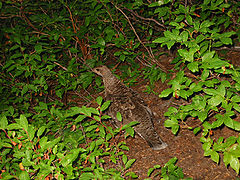- Dendragapus
-
"Blue Grouse" 
Male Dusky Grouse displaying, Yellowstone NP; note purple air sac and red eye wattle Scientific classification Kingdom: Animalia Phylum: Chordata Class: Aves Order: Galliformes Family: Phasianidae Subfamily: Tetraoninae Genus: Dendragapus
Elliot, 1823Species Dusky Grouse Dendragapus obscurus
Sooty Grouse Dendragapus fuliginosusSynonyms Palaeotetrix
The genus Dendragapus, contains two closely related species of grouse that have often been treated as a single variable taxon (Blue Grouse). The two species are the Dusky Grouse (Dendragapus obscurus) and the Sooty Grouse (Dendragapus fuliginosus).[1] In addition, the Spruce Grouse and Siberian Grouse have been considered part of this genus.
Description
These are large grouse that inhabit highland regions of North America and Eurasia. The Sooty Grouse is found in the Pacific Coast Ranges and Sierra Nevada, and the Dusky Grouse in the Rocky Mountains.[2][3][4] These two taxa were originally regarded as separate species, but were considered conspecific for much of the twentieth century. However, in 2006 the American Ornithologists' Union re-split them,[1] following the DNA-based work of Barrowclough et al. (2004).[5] whose results supported the earlier work of Brooks (1929) [6] who regarded the two taxa as separate species based on morphology, behavior and vocalizations. The precise ranges of the two species are well-defined in the south, separated by extensive areas of unsuitable forest-free habitat, but somewhat uncertain in the north of the range of the genus where there is no separation; Barrowclough et al.'s study did not include these northern populations.
Adults have a long square tail, gray at the end (lighter in the Sooty Grouse). Adult males are mainly dark (especially Sooty Grouse) with a yellow (Sooty Grouse) or purplish (Dusky Grouse) throat air sac surrounded by white, and a yellow (Sooty Grouse) or yellow to red (Dusky Grouse) wattle over the eye during display. Adult females of both species are mottled brown with dark brown and white marks on the underparts.[4]
Their breeding habitat is the edges of conifer and mixed forests in mountainous regions of North America and Eurasia. Their range is closely associated with that of various conifers. The nest is a scrape on the ground concealed under a shrub or log.
All species have healthy populations, except for some population decline and habitat loss of the Sooty Grouse at the southern end of its range in southern California.,[2] and the Siberian Grouse which is considered near-threatened.
Fossils
Late Pleistocene fossil species that have been described are Dendragapus gilli (western and west-central USA), initially placed in a distinct genus Palaeotetrix, and Dendragapus lucasi (known only from Fossil Lake, USA).
References
- ^ a b Banks, R. C.; Cicero, C., Dunn, J. L., Kratter, A. W., Rasmussen, P. C., Remsen, J. V., Jr., Rising, J. D., & Stotz, D. F. (2006). "Forty-seventh Supplement to the American Ornithologists' Union Check-list of North American Birds". The Auk 123 (3): 926–936. doi:10.1642/0004-8038(2006)123[926:FSTTAO]2.0.CO;2. ISSN 0004-8038. http://www.aou.org/checklist/suppl/AOU_checklist_suppl_47.pdf. Retrieved 2007-09-16.
- ^ a b del Hoyo, J., Elliott, A., & Sargatal, J., eds. (1994). Handbook of the Birds of the World 2: 401-402. Lynx Edicions, Barcelona ISBN 84-87334-15-6.
- ^ Zwickel, Fred C.; Bendell, James F. (2004). Blue Grouse: Their Biology and Natural History. Ottawa: NRC Research Press. ISBN 978-0-660-19271-0. http://pubs.nrc-cnrc.gc.ca/eng/books/books/9780660192710.html.
- ^ a b Sibley, D. (2000). The Sibley Guide to Birds. Knopf. pp. 143. ISBN 0-679-45122-6.
- ^ Barrowclough, G. F., Groth, J. G., Mertz, L. A., & Gutierrez, R. J. (2004). Phylogeographic structure, gene flow and species status in Blue Grouse (Dendragapus obscurus). Molecular Ecology 13: 1911–1922. Available online (pdf file).
- ^ Brooks, A. (1929). On Dendragapus obscurus obscurus. The Auk 46: 111–113. Available online (pdf file).
Categories:- Tetraonidae
- Genera of birds
Wikimedia Foundation. 2010.

